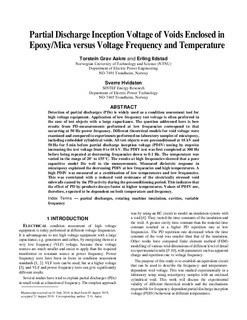| dc.contributor.author | Aakre, Torstein Grav | |
| dc.contributor.author | Ildstad, Erling | |
| dc.contributor.author | Hvidsten, Sverre | |
| dc.date.accessioned | 2020-02-13T11:41:27Z | |
| dc.date.available | 2020-02-13T11:41:27Z | |
| dc.date.created | 2020-02-10T09:22:35Z | |
| dc.date.issued | 2020 | |
| dc.identifier.citation | IEEE transactions on dielectrics and electrical insulation. 2020, 27 (1), 214-221. | nb_NO |
| dc.identifier.issn | 1070-9878 | |
| dc.identifier.uri | http://hdl.handle.net/11250/2641515 | |
| dc.description.abstract | Detection of partial discharges (PDs) is widely used as a condition assessment tool for high voltage equipment. Application of low frequency test voltage is often preferred in the case of test objects with a large capacitance. The question addressed here is how results from PD-measurements performed at low frequencies correspond to that occurring at 50 Hz power frequency. Different theoretical models for void voltage were examined and compared to experiments performed on laboratory samples of mica/epoxy, including embedded cylindrical voids. All test objects were preconditioned at 10 kV and 50 Hz for 5 min before partial discharge inception voltage (PDIV) testing by stepwise increasing the test voltage from 0 to 10 kV. The PDIV test was first completed at 300 Hz before being repeated at decreasing frequencies down to 0.1 Hz. The temperature was varied in the range of 20° to 155°C. The results at high frequencies showed that a pure capacitive model fits well to the measurements. Measured dielectric response in mica/epoxy explained the decreasing PDIV at low frequencies and high temperatures. A high PDIV was measured at a combination of low temperatures and low frequencies. This was correlated with a reduced void resistance of the electrically stressed void sidewalls caused by the PD activity during the preconditioning period. This indicates that the effect of PD by-products decays faster at higher temperatures. Values of PDIV are, therefore, expected to be dependent on both temperature and frequency. | nb_NO |
| dc.language.iso | eng | nb_NO |
| dc.publisher | Institute of Electrical and Electronics Engineers (IEEE) | nb_NO |
| dc.title | Partial Discharge Inception Voltage of Voids Enclosed in Epoxy/Mica versus Voltage Frequency and Temperature | nb_NO |
| dc.type | Journal article | nb_NO |
| dc.type | Peer reviewed | nb_NO |
| dc.description.version | acceptedVersion | nb_NO |
| dc.source.pagenumber | 214-221 | nb_NO |
| dc.source.volume | 27 | nb_NO |
| dc.source.journal | IEEE transactions on dielectrics and electrical insulation | nb_NO |
| dc.source.issue | 1 | nb_NO |
| dc.identifier.doi | 10.1109/TDEI.2019.008394 | |
| dc.identifier.cristin | 1792441 | |
| dc.description.localcode | © 2019 IEEE. Personal use of this material is permitted. Permission from IEEE must be obtained for all other uses, in any current or future media, including reprinting/republishing this material for advertising or promotional purposes, creating new collective works, for resale or redistribution to servers or lists, or reuse of any copyrighted component of this work in other works. | nb_NO |
| cristin.unitcode | 194,63,20,0 | |
| cristin.unitname | Institutt for elkraftteknikk | |
| cristin.ispublished | true | |
| cristin.fulltext | postprint | |
| cristin.qualitycode | 2 | |
